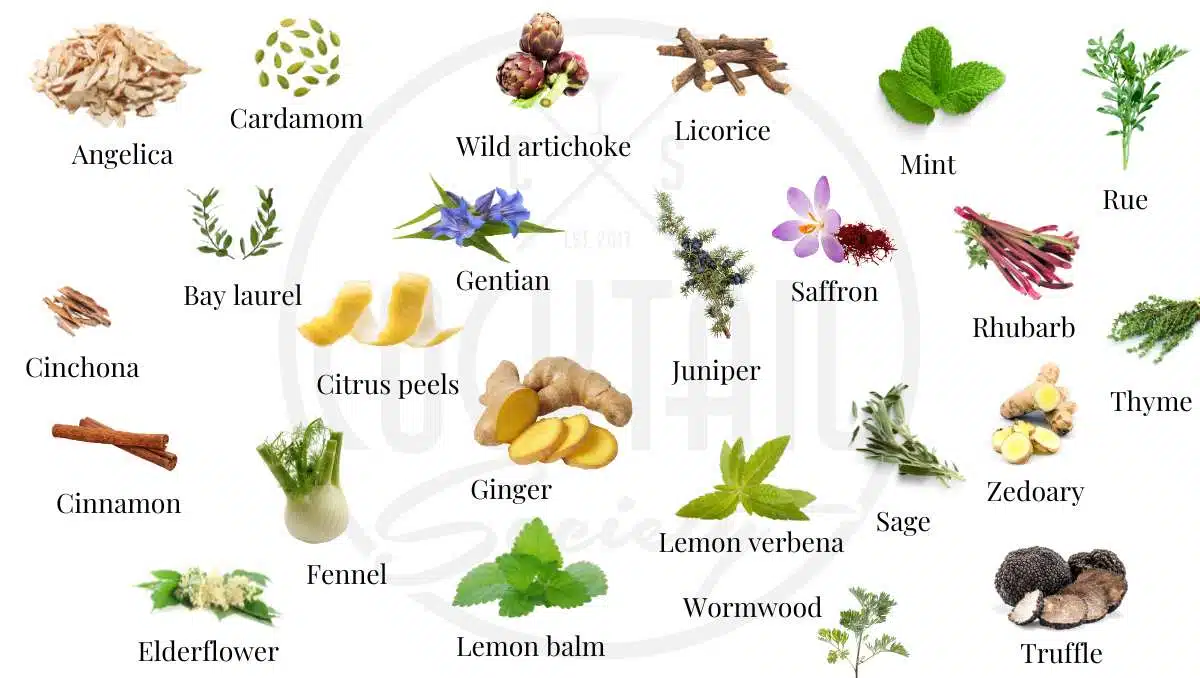Amaro is the Italian word for bitter and also the name of a popular category of liqueurs. In a nutshell, these are sweet to medium-sweet herbal bitter liqueurs made in Italy. The ingredients to flavor the liqueur, the base alcohol, and the general taste within the category can vary. Hence, Amaro comes in various styles and types. The most common ones are:
- Alpine Amaro
- Aperitivo
- Carciofo
- Chinato
- Fernet
- Genepy
- Light Amaro
- Medium Amaro
- Rabarbaro
- Tartufo
- Vermouth
Some of the most popular brands producing Amaro, like Campari, Fernet Branca, Cynar, and Amaro Nonino, belong to different sub-categories. Campari is an Aperitivo, Fernet Branca belongs to the namesake Fernet category, Cynar is a Carciofo, and Amaro Nonino belongs to the so-called Medium-Amaro.
Here's an overview of the most common Amaro styles to help you identify the differences.
1. Alpine Amaro
This style of Amaro is just what it sounds like. It is flavored with various herbs, mainly growing in the alpine mountains.
Among the better-known representatives are Amaro Braulio, Alpe Lys Amaro, Amaro Walser, and Amaro Herbae.
2. Aperitivo
This category is relatively light and famous for its bright red color. The bitter liqueurs are an integral part of Italy's aperitivo culture. These lighter Amaro liqueurs are often colored with cochineal or other intensely red colorings.
The most influential brand is Campari. Some of the best Campari substitutes, like Luxardo Bitter, Cappelletti, and Contratto bitter, also belong to this Amaro sub-category.
3. Carciofo
This Amaro type is flavored with artichokes. Some may know that Cynar is made and flavored with artichokes, but only a few know there's a whole sub-category.
Other bottles in this sub-category are Cynar 70 proof Amaro, Aplomado Herbal Amaro, Don Ciccio & Figli C3 Carciofo Aperitivo, and Amacardo Amaro di Carciofo.
4. Chinato
Cinchona bark is probably most famous as the bittering ingredient in tonic water, lending the mixer its distinct taste. But the bark is also used for producing Amaro Chinato.
Predominantly, Chinato Amari can be found in Piedmont, Northern Italy. Cocchi Storico Vermouth di Torino is probably the most popular bottle in this category. Others are Cocchi Barolo Chinato, Nardini Elixir China, and Clementi Antico China Elixir.
5. Fernet
Fernet Branca, or Fernet in general, is also a stand-alone style of Amaro. Only a few know that there are many others besides the popular Branca. Some of them make for excellent Fernet Branca alternatives like Fernet Stock.
A Fernet is typically strongly bitter with a minty taste and has a comparably high amount of alcohol.
6. Genepy
This style of Amaro liqueurs is made with wormwood, also known as artemisia. Quaglia Genepy, Distilleria Alpe Genepy Herbetet, and Rossi D'Angers are part of this Amaro type.
7. Light Amaro
Light Amari is modest in alcohol and subtle in taste. This rather broad definition is also why the variation in this sub-category is enormous. The products of brands like Ramazzotti, Luxardo (Bitter Bianco), Amaro Montenegro, and Amaro Tosolini are all part of it.
8. Medium Amaro
This type is the most common. Bottles usually contain around 30-32% ABV and are semi-sweet with a balanced bitter taste.
Many bestselling Amari are defined as "Medium" like Amaro Nonino Quintessentia, Amaro Averna, Amer Picon, Amaro D'Erbe, and Amaro Meletti.
9. Rabarbaro
Similar to the "Carciofo"-style, Rabarbaro is a category that produces liqueurs based on a rare flavoring ingredient; -in this case, rhubarb.
Rabarbero Amari often have a slightly smoky taste. Among the few products in this list are Rabarbaro Zucca Amaro, Sfumato Rabarbaro, and Nardini Rabarbaro.
10. Tartufo
Tartufo is the Italian word for truffle. There are only a few Tartufo Amari, but all impart the delicate and distinct flavors of the luxurious fungus. You'll hardly get your hands on these liqueurs outside of Italy. Even within the country, Tartufo Amaro liqueurs are a rarity.
Some of the more popular bottles are Amaro al Tartufo Nero di Norcia, Liquore Amaro al Tartufo Francescano, and Amaro al Tartufo Nero Pregiato di Norcia.
11. Vermouth
Vermouth is a fortified wine flavored with a selection of herbal ingredients. Only a few know that Vermouth is actually a specific Amaro style made with a wine base. Due to the lower alcohol content of the base alcohol, Vermouth also applies a different technique to infuse flavors.
The most renowned members are Carpano Antica Formula, Punt e Mes, Riserva Carlo Alberto Vermouth, and Matter Vermouth.
12. Others
In addition to the listed styles, there are many very specific sub-types. They're usually based on quite distinct and rarely used ingredients and are regional specialties.
Common Flavorings Used for Amaro
A huge variety of herbs, plants, spices, and roots is used to flavor Amari. There's no unified recipe and no specific restrictions, so the recipes between different styles and brands may vary a lot. The Amaro types described above often differentiate themselves from others by using unique ingredients.

The most common flavors used in Amaro liqueurs are:
- Angelica root
- Bay laurel
- Cardamom
- Cinchona bark
- Cinnamon
- Citrus peels
- Elderflower
- Fennel
- Gentian
- Ginger
- Juniper
- Lemon balm
- Lemon verbena
- Licorice root
- Mint
- Rue
- Rhubarb
- Saffron
- Sage
- Thyme
- Truffle
- Wormwood
- Wild artichoke (cardoon)
- Zedoary

